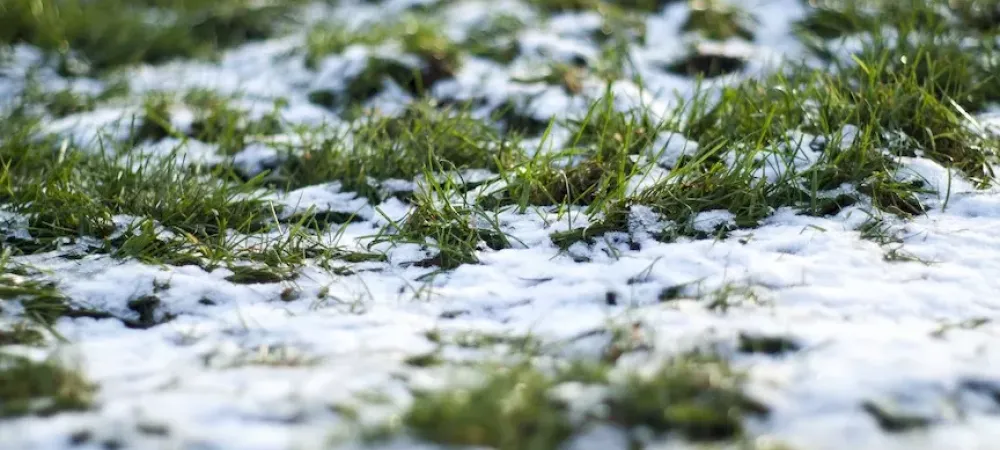How To Prevent Winter Damage to Your Lawn

When the snow finally melts away in the spring, it can sometimes reveal a lawn that is dead and brown instead of grass that was dormant and is getting ready to thrive. Here are a few tips to identify the causes of winter kill so you know how to react and how to prevent extensive winter lawn damage from:
What is Winter Kill?
Winter kill is a chilling term used to describe all winter lawn damage that causes damage or death to the grass and plants in your yard. Here in Michigan, with our long and frigid winters, our grass has a lot to contend with. Violent snowstorms, freezing ice storms, dangerously cold temperatures, moisture-stealing wind, and hungry critters are just a few of the common facets of winter kill.
What Causes Winter Lawn Damage?
The majority of the problems that your lawn will face during the winter come down to one problem—the drop in temperature, which can lead to and accentuate issues such as winter desiccation, vole damage, snow mold, and crown hydration.
Winter Desiccation
Winter desiccation is first on our list. This terrible winter lawn damage is caused by freezing temperatures and dry wind. When there is no snow cover, the grass remains exposed to the moisture-sucking dry wind. The wind rips the water right out of the grass, causing it to dry up. The frozen ground restricts the roots from absorbing any water to replenish what is lost. Ultimately, winter desiccation results in grass dehydration and death.
How to Prevent Winter Desiccation?
Because winter desiccation is caused by specific weather conditions, it’s not very easy to prevent. The bottom line is that it can only be prevented by boosting the health, strength, and resilience of your turf throughout the year with efficient lawn care and careful maintenance. Proper lawn care makes your grass more resilient against environmental stresses, weeds, pests, and turf diseases.
Vole Damage
Voles can cause a lot of winter lawn damage to turfs and are one of the most common causes of winter kill. Voles may be tiny rodents, but their damage is not to be taken lightly. A hungry vole travels through your grass under the cover of snow, chowing down on your grass as it goes. In the spring, you’ll find an impressive network of overlapping paths through your grass.
How to Prevent Vole Damage?
You can prevent voles from taking up residence in your yard by doing a bit of fall lawn maintenance.
- Clear your lawn of all leaves and debris to eliminate vole hiding places.
- Trim low branches of trees and shrubs to eliminate ground cover and make sure you continue mowing your grass until the first frost.
While it may look ugly, vole damage can easily be repaired. The narrow paths of chewed and dead grass will grow back quickly as the temperatures go up.
Snow Mold
Snow mold is a spring nightmare for homeowners everywhere. This quick-growing fungus starts growing in the winter, under the cover of snow. It takes advantage of unhealthy lawns, growing in long, matted grass and excess thatch.
- Gray snow mold is characterized by white or gray mold growing in circular patches of wet grass.
- Pink snow mold, on the other hand, is red, pink, or copper-colored and is extremely destructive to the turf as it attacks the roots and crown.
Watch for the first signs of snow mold in the early spring, when the snow starts to melt.
How to Prevent Snow Mold?
The best control for snow mold is active prevention throughout the year. This means you’ll need to provide your lawn with everything it needs throughout the spring, summer, and fall. Maintenance in the fall is essential too.
- Mow your grass until the first frost to reduce the amount of matted grass when it snows.
- Get rid of all the debris and leaves on your turf before the snow starts to fly.
- Aerate your lawn in the fall. Not only does it help break up the thatch, snow mold’s favorite home, but it also helps with drainage, eliminating the threat of excess water.
Crown Hydration
Crown hydration is one of the most destructive causes of winter kill here in Michigan. Like desiccation, it relies on extreme weather conditions during the winter. When temperatures climb above freezing, your grass starts to wake up and take in water from the roots. It stores the water in the crown. If the temperatures were to suddenly plummet to below freezing again, then it would result in quickly freezing the grass. Unfortunately, all that stored water freezes and rapidly expands, rupturing the cells of the plant and killing the grass.
How to Prevent Crown Hydration?
Crown hydration can be averted with consistent lawn care throughout the entire year. Keeping your turf well-fertilized, free of pests, weed-free, and healthy all year allows the grass to become tough and hardy. In the winter, your grass will be strong enough to withstand the rigors of winter.
How to Repair Winter Damage
Depending on how bad the damage to your lawn is, you have two options:
- Aeration and Seeding: In most cases, your grass can be revived. Aerating your turf helps to break up thatch, allowing nutrients, water, and air to reach the roots, while overseeding helps to fill in bare spots where the grass has died off.
- Re-sod your Turf: In more severe cases, you may have to remove all of the damaged grass and replace it with new sod.
In either case, we recommend that you reach out to a local lawn care company, such as 4-EverGreen. Our local experts have the experience to help you make the best decision for your turf by offering assessments, soil tests, and customized lawn care recommendations. We also offer a 6-step Lawn Care Program that can help you revitalize your grass.
